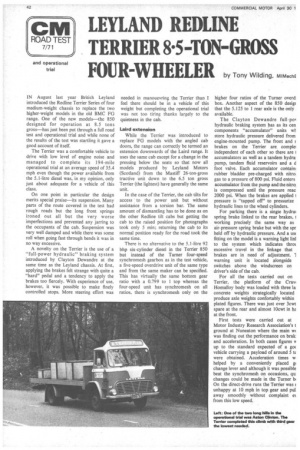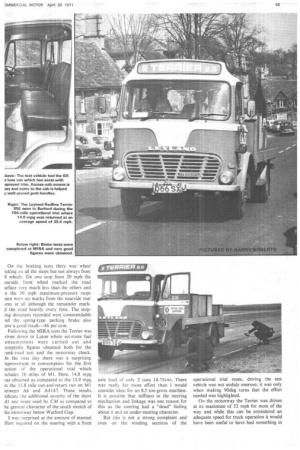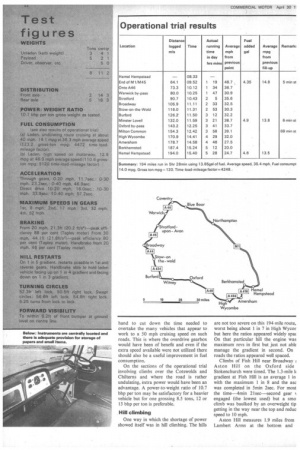LEYLAND REDLINE TERRIER 8•5—TON—GROSS
Page 44

Page 45

Page 46

Page 47

If you've noticed an error in this article please click here to report it so we can fix it.
FOUR —WHEELER by Tony Wilding, mechi
IN August last year British Leyland introduced the Redline Terrier Series of four medium-weight chassis to replace the two higher-weight models in the old BMC FG range. One of the new models—the 850 designed for operation at 8.5 tons gross—has just been put through a full road test and operational trial and while none of the results of the test was startling it gave a good account of itself.
The Terrier was a comfortable vehicle to drive with low level of engine noise and managed to complete its 194-mile operational trial at an average speed of 35.4 mph even though the power available from the 5.1-litre diesel was, in my opinion, only just about adequate for a vehicle of this class.
On one point in particular the design merits special praise—its suspension. Many parts of the route covered in the test had • rough roads but the long front springs ironed out all but the very worse imperfections and prevented any jarring to the occupants of the cab. Suspension was very well damped and while there was some roll when going fast through bends it was in no way excessive.
A novelty on the Terrier is the use of a "full-power hydraulic" braking system introduced by Clayton Dewandre at the same time as the Leyland chassis. At first, applying the brakes felt strange with quite a "hard" pedal and a tendency to apply the brakes too fiercely. With experience of use, however, it was possible to make finely controlled stops. More steering effort was needed in manouevring the Terrier than I feel there should be in a vehicle of this weight but completing the operational trial was not too tiring thanks largely to the quietness in the cab.
Laird extension
While the Terrier was introduced to replace FG models with the angled cab doors, the range can correctly be termed an extension downwards of the Laird range. It uses the same cab except for a change in the pressing below the seats so that now all models produced by Leyland Motors (Scotland) from the Mastiff 26-ton-gross tractive unit down to the 6.5 ton gross Terrier (the lightest) have generally the same unit.
In the case of the Terrier, the cab tilts for access to the power unit but without assistance from a torsion bar. The same amount of dismantling has to be done as on the other Redline tilt cabs but getting the cab to the raised position for photographs took only 5 min; returning the cab to its normal position ready for the road took the same time.
There is no alternative to the 5.1-litre 92 bhp six-cylinder diesel in the Terrier 850 but instead of the Turner four-speed synchromesh gearbox as in the test vehicle, a five-speed overdrive unit of the same type and from the same maker can be specified. This has virtually the same bottom gear ratio with a 0.799 to 1 top whereas the four-speed unit has synchromesh on all ratios, there is synchromesh only on the higher four ratios of the Turner overd box. Another aspect of the 850 desigr that the 5.125 to 1 rear axle is the only available: The Clayton Dewandre full-poi hydraulic braking system has as its cen components "accumulator" units wF store hydraulic pressure delivered from engine-mounted pump. The front and r brakes on the Terrier are complei independent of each other so there are 1 accumulators as well as a tandem hydra pump, tandem fluid reservoirs and a d foot valve. Each accumulator contain! rubber bladder pre-charged with nitro gas to a pressure of 800 psi. Fluid enters accumulator from the pump and the nitro is compressed until the pressure reac 2000 psi. When the brakes are applied 1 pressure is "tapped off" to pressurize hydraulic lines to the wheel cylinders.
For parking there is a single hydra spring brake linked to the rear brakes, 1 working precisely the same way as air-pressure spring brake but with the spr held off by hydraulic pressure. And a usr fitting on the model is a warning light linl to the system which indicates throt excessive travel in the linkage that brakes are in need of adjustment. 1 warning unit is located alongside switches above the windscreen on driver's side of the cab.
For all the tests carried out on Terrier, the platform of the Cravi Hornalloy body was loaded with three la concrete weights strategically located produce axle weights confortably within plated figures. There was just over 3cwt spare at the rear and almost lOcvit in he at the front.
First tests were carried out at Motor Industry Research Association's t ground at Nuneaton where the main wr was finding out the performance on brals: and acceleration. In both cases figures vi up to the standard expected of a got vehicle carrying a payload of around 5 tt were obtained. Acceleration times w helped by a conveniently placed gi change lever and although it was possible beat the synchromesh on occasions, qa changes could be made in the Turner 131 On the direct-drive runs the Terrier was unhappy at 10 mph in top gear and pul away smoothly without complaint el, from this low speed. On the braking tests there was wheel 'eking on all the stops but not always from 11 wheels. On one stop from 20 mph the earsidc front wheel marked the road urface very much less than the others and n the 30 mph maximum-pressure stops 'Jere were no marks from the nearside rear yres at all although the remainder markd the road heavily every time. The stoning distances recorded were commendable nd the spring-type parking brake also ave a Rood result-46 per cent.
Following the MIRA tests the Terrier was riven down to Luton where set-route fuel onsumptions were carried out and cceptablc figures obtained both for the runk-road test and the motorway check. )n the next day there was a surprising nprovement in consumption for the first ection of the operational trial which acludes 56 miles of Ml. Here, 14.8 mpg vas obtained as compared to the 12.9 mpg al the 15.8 mile out-and-return run on MI oetween Ab and A4147. These results ndicate the additional severity of the short test route used by CM as compared to he general character of the south stretch of his motorway below Watford Gap.
I was surprised at the amount of manual [Tort required on the steering with a front axle load of only 2 tons 14.75ewt. There was really far more effort than I would consider ideal for an 8.5-ton-gross machine. It is possible that stiffness in the steering mechanism and linkage was one reason for this as the steering had a "dead" feeling about it and an under-steering character.
But this is not a strong complaint and even on the winding sections of the operational trial route, driving the test vehicle was not unduly onerous; it was only when making 90deg turns that the effort needed was highlighted.
On the motorway the Terrier was driven at its maximum of 52 mph for most of the way and while this can be considered an adequate speed for truck operation it would have been useful to have had something in hand to cut down the time needed to overtake the many vehicles that appear to work to a 50 mph cruising speed on such roads. This is where the overdrive gearbox would have been of benefit and even if the extra speed available were not utilized there should also be a useful improvement in fuel consumption.
On the sections of the operational trial involving climbs over the Cotswolds and Chilterns and where the• road is rather undulating, extra power would have been an advantage. A power-to-weight ratio of 10.7 bhp per ton may be satisfactory for a heavier vehicle but for one grossing 8.5 tons, 12 or 13 bhp per ton is preferable.
Hill climbing One way in which the shortage of power showed itself was in hill climbing. The hills are not too severe on this 194 mile route, worst being about 1 in 7 in High Wycor but here the ratios appeared widely spat On that particular hill the engine was maximum revs in first but just not ablc manage the gradient in second. On roads the ratios appeared well spaced.
Climbs of Fish Hill near Broadway Aston Hill on the Oxford side Stokenchurch were timed. The 1.3-mile 14 gradient at Fish Hill is an average 1 in with the maximum 1 in 8 and the asc was completed in 5min 2sec. For most the time-4min 21sec-second gear engaged (the lowest used) but a smo climb was baulked by an overweight tip getting in the way near the top and reduc speed to 10 mph.
Aston Hill measures 1.9 miles from Lambert Arms at the bottom and
.adient is fairly even at 1 in 14. Total time r the climb was 4min 51sec of which 4min lsec was spent in third which was just lequate for the steepest part when the Iced dropped to 16mph.
tobust vehicle Taken all round this was a very .tisfactory test and the Terrier gave the ipression of being a robust vehicle ipable of giving good service with asonable economy to an operator. A iver should be satisfied with the vehicle r he has a roomy cab, well fitted out and ith comfortable seats. All-round visibility good and all controls are easily reached. lie clutch is light enough and the :celerator well placed and there is !equate provision for storage of papers id small items with cabby holes on each k of the dash and (in the case of the GX luxe cab on the test vehicle) large door )ckets.
Instruments are located in a central teelle on the facia with the speedometer the middle and gauges for water mperature, fuel level, battery charge and 1 temperature surrounding it.
Entry to the cab from both sides is cilitated by well-placed grab handles -laden floor height of the cab is 3ft and the 'St step is lft 9in. from the ground. And )thing gets in the way of across-cab :cess.
As tested. the Terrier 850 has a iassis /cab list price of £1690. The GX cab his £37 making a total £1727 and the ravens Homalloy platform body is priced £269.




























































































